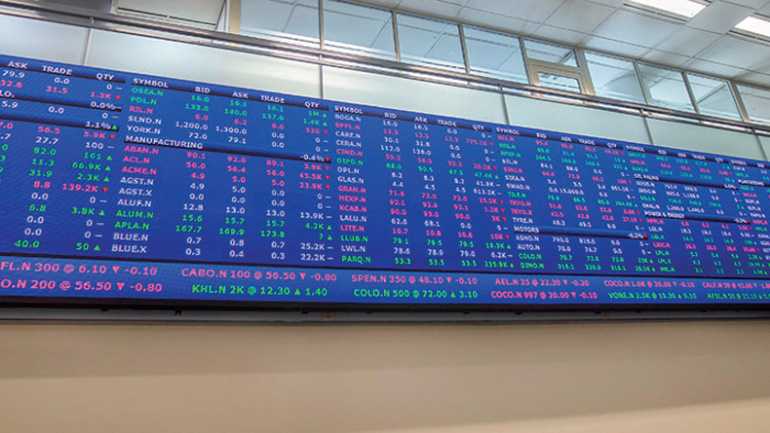Friday Mar 28, 2025
Friday Mar 28, 2025
Tuesday, 24 March 2020 02:31 - - {{hitsCtrl.values.hits}}

By the Colombo Stock Exchange
Halting trading of the market due to an extreme decline in a particular index during the day, as a result of the share prices falling rapidly, is a measure that is implemented by stock markets around the world.
Trading Halts triggered by circuit breakers were a common occurrence during the recent weeks and continue to be so in stock markets globally, as the investment community responds to global economic implications of the COVID-19 pandemic.
According to the World Federation of Exchanges, market volatility surrounding the COVID-19 pandemic has reached levels comparable with the Global Financial Crisis of 2008, with one-day losses not seen since 1987.
A similar trend was visible on the Colombo Stock Exchange (CSE) as well, with a 30-minute Market Halt being imposed on 10, 12, 13 and 20 March 2020 due to the S&P SL 20 index declining over 5% from the previous day’s closing levels.
A Market Halt is applicable to trading on all securities and is imposed as a measure to provide a “cooling off” period during a steep decline in the share prices. Market Halts offer an opportunity for the investors to closely consider the available information and review their investment strategies in the wake of a rapidly-declining market.
The exact methodologies governing Market Halts vary in stock markets around the world and such measures are taken by stock exchanges globally with the objective of addressing unanticipated volatility. Hence, imposing a Market Halt is a key tool utilised by exchanges to maintain a fair and orderly market.
How does a Market Halt work at CSE?
An initial Market Halt is imposed on all securities traded on the CSE temporarily for a period of 30 minutes in the event of the S&P SL 20 index recording a decline of above 5% compared to the previous day’s closing level.
Further Market Halts may be imposed within the same trading day in the event the S&P SL 20 index records a further decline of above 5% upon re-opening the market following the initial Market Halt. Essentially, the market will be halted for a period of 30 minutes at every 5% decline in the S&P SL 20 index within a trading day.
For an instance, a Market Halt will be imposed upon the S&P SL 20 Index declining by over 5% during a particular day of trading, only to commence trading 30 minutes later. Should the market continue to fall to over 10% during the same day of trading, another Market Halt will be imposed. Similarly, Market Halts may be imposed at every 5% decline thereafter.
A Market Halt does not mean a shutdown for the day
As indicated above, a Market Halt is imposed as a 30-minute temporary suspension of trading of securities within a market environment, with the objective of recommencing market operations after a brief recess.
As a Market Halt is imposed, the CSE continues all other operational aspects to ensure that regular trading can commence upon completing the 30-minute halt period.
A Market Halt does not result in an end of trading for the day, unless the halt is imposed at 2 p.m. or later, where the 30-minute halt would remain in effect till the end of the scheduled regular trading, which usually takes place at 2:30 p.m. at CSE.
Market Halts are not a panic or ad-hoc measure by stock exchanges.
Market Halts are a well-coordinated, pre-defined measure by the CSE to mitigate the sudden effects of an extreme price decline and is conducted in the best interest of the investment community and capital market stakeholders.
The Market Halt mechanism mentioned above is in line with measures taken by leading stock exchanges around the world and has been introduced by closely considering the context of the Sri Lankan stock market.
Discover Kapruka, the leading online shopping platform in Sri Lanka, where you can conveniently send Gifts and Flowers to your loved ones for any event including Valentine ’s Day. Explore a wide range of popular Shopping Categories on Kapruka, including Toys, Groceries, Electronics, Birthday Cakes, Fruits, Chocolates, Flower Bouquets, Clothing, Watches, Lingerie, Gift Sets and Jewellery. Also if you’re interested in selling with Kapruka, Partner Central by Kapruka is the best solution to start with. Moreover, through Kapruka Global Shop, you can also enjoy the convenience of purchasing products from renowned platforms like Amazon and eBay and have them delivered to Sri Lanka.
Discover Kapruka, the leading online shopping platform in Sri Lanka, where you can conveniently send Gifts and Flowers to your loved ones for any event including Valentine ’s Day. Explore a wide range of popular Shopping Categories on Kapruka, including Toys, Groceries, Electronics, Birthday Cakes, Fruits, Chocolates, Flower Bouquets, Clothing, Watches, Lingerie, Gift Sets and Jewellery. Also if you’re interested in selling with Kapruka, Partner Central by Kapruka is the best solution to start with. Moreover, through Kapruka Global Shop, you can also enjoy the convenience of purchasing products from renowned platforms like Amazon and eBay and have them delivered to Sri Lanka.